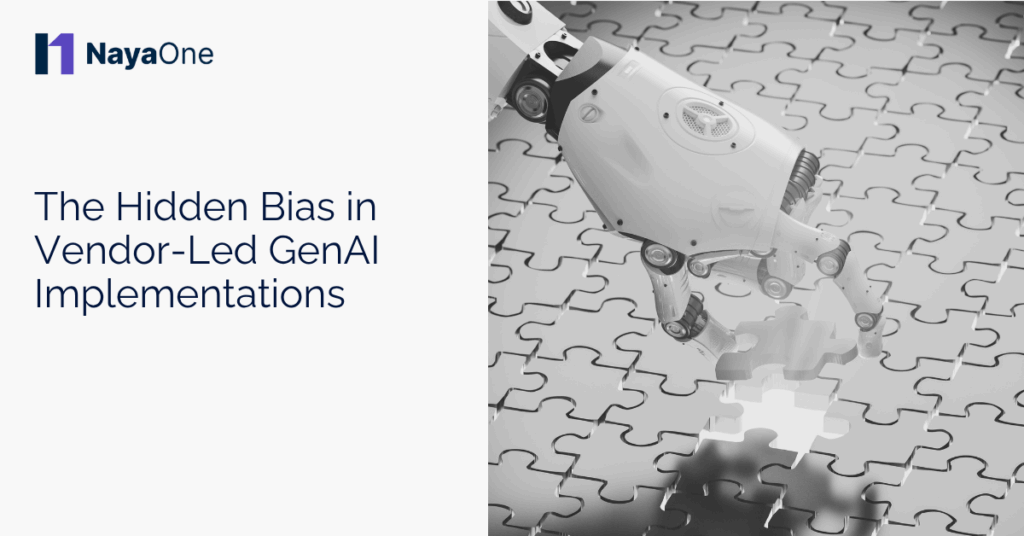Why financial institutions must scrutinise before they scale
The adoption of generative AI in financial services is accelerating, shaped in large part by the external ecosystem that surrounds it – vendors, solution providers, and technology platforms offering off-the-shelf tools and rapid deployment promises.
At first glance, this seems like a welcome development: new capability delivered quickly, with minimal friction.
But beneath the surface lies a more nuanced and, at times, underappreciated challenge: the risk of hidden bias in vendor-led implementations.
Not the bias within the model itself – although that remains a concern – but rather the institutional risks that arise when enterprises evaluate AI tools on vendor terms, not their own.
The Nature of the Problem: Asymmetry of Evaluation
Financial institutions are not new to vendor management. But GenAI presents a different dynamic:
- The models are opaque
- The outputs are stochastic
- The governance frameworks are still evolving
- And the speed of advancement outpaces traditional validation methods
As a result, many organisations are relying on vendor-led demonstrations, use case packaging, and pre-defined success metrics as a proxy for fit.
In doing so, they absorb more than a product – they absorb the vendor’s assumptions.
And that’s where the bias begins.
Five Forms of Hidden Bias in GenAI Procurement
1. Data Context Mismatch
Models trained on open or third-party data sources often fail to reflect the regulated, domain-specific environments of financial services.
Yet these models are frequently evaluated in isolation, producing outputs that seem compelling – but behave unpredictably when prompted with actual operational complexity.
What’s needed is a validation process that tests models using domain-specific data – ideally synthetic, and structurally similar to real customer, product, or legal datasets.
2. Success Metrics Misalignment
Many vendors promote GenAI tools with metrics like response speed, user satisfaction, or productivity uplift.
But banks and insurers must ask different questions:
- Is the model auditable?
- Can its outputs be traced?
- Does it comply with explainability obligations?
What looks like a successful PoC through one lens may be a compliance liability through another.
3. Environmental Blind Spots
Demo environments are optimised to showcase performance. Real enterprise environments are not.
There are legacy systems, permissioning rules, latency constraints, and downstream dependencies that do not feature in a vendor pitch.
Evaluating a model without simulating these conditions creates a dangerous illusion of readiness – one that collapses under the weight of production realities.
4. Organisational Asymmetry
When AI validation is led exclusively by business or innovation teams, key functions – risk, legal, procurement, architecture – are often brought in too late, if at all.
This creates fragmented accountability, unclear escalation pathways, and internal exposure that only becomes apparent after deployment.
5. Reputational Transfer Risk
Perhaps the most critical: when a vendor-led AI tool produces harmful or inexplicable outcomes, the reputational damage accrues not to the vendor, but to the institution deploying it.
Customers, regulators, and the public will not differentiate between who built the model and who chose to trust it.
From Frictionless Adoption to Structured Validation
None of this is a case against working with vendors. Rather, it is a case for restoring balance in the validation process.
To avoid hidden bias, institutions must bring AI validation back within their governance perimeter.
That requires purpose-built infrastructure to:
- Evaluate tools under realistic, production-like conditions
- Use financial-grade synthetic data to simulate behaviour
- Run structured PoCs that include technical, legal, and risk stakeholders
- Generate evidence that informs - rather than defers - decision-making
A Leadership Moment for Institutions
There will always be commercial pressure to move quickly – to show momentum, adopt new capabilities, or keep pace with peers.
But in financial services, trust is not a trailing concern – it is the precondition for innovation.
The institutions that lead in GenAI adoption will not be those that onboard fastest.
They will be those that validate first – and do so with rigour.
Because in a space where models evolve weekly, and where opacity is built into the architecture, governance becomes the competitive edge.
And the cost of discovering bias too late will be paid not in theory – but in audit findings, regulatory actions, and reputational harm.
Exploring GenAI adoption at your institution?
Join a 30-minute session to assess your current posture and explore how structured validation could support your roadmap.
Download our GenAI whitepaper: Is Your Bank AI-Ready?





